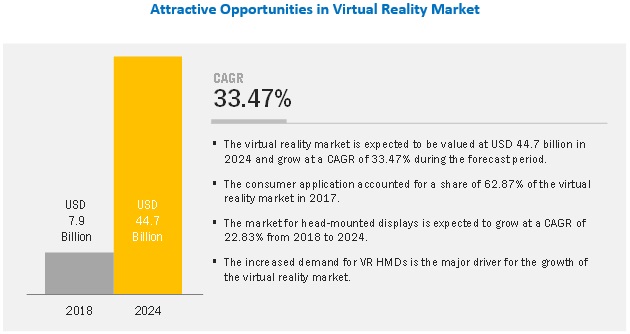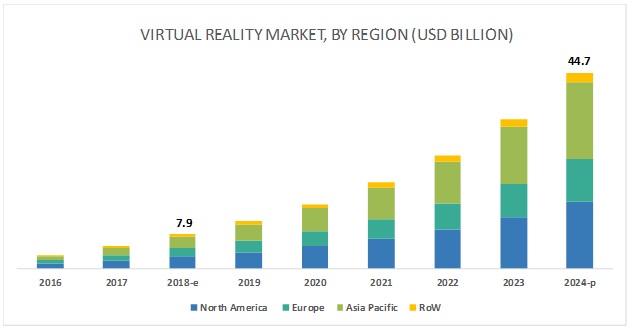The VR MARKET FORECAST
The virtual reality market is expected to grow from USD 7.9 billion in 2018 to USD 44.7 billion by 2024, at a CAGR of 33.47% during the forecast period. The penetration of HMDs in the gaming and entertainment sector, huge investments in VR market, advancement of technology and growing digitization, and availability of affordable VR devices are the major factors fueling the growth of the overall market.

Gesture-tracking devices to grow at highest CAGR during forecast period.
Gesture-tracking devices are used as input devices for VR systems. These tracking devices track the user’s movements and enable the user to interact with the virtual environment. Gesture-tracking devices include data gloves, treadmills, and controllers to facilitate gesture and action tracking in VR applications. The use of gesture-tracking devices in gaming and entertainment and healthcare applications will play a crucial role to boost their growth in the VR market.
Retail and ecommerce applications to have significant share in virtual reality market
In the retail sector, virtual reality technology is used in virtual fashion stores for designing virtual avatars for the selection of clothes or accessories, fashion shows, and so on. Virtual environments are used in many applications of marketing as they are helpful in demonstrating and displaying product- and business-related information and creating awareness among potential buyers. Virtual reality can show a 360° view of a product or device (online or at the point of business), by which a potential customer gets a better insight. In online shopping, items such as apparels, jewelry, spectacle frames, and others can be viewed closely by zooming in and out. On a few websites, a user can even virtually try the outfit. Increased use of VR technology will help drive the retail and ecommerce VR market.

North America to account for significant share in virtual reality market during forecast period
North America, being a developed and technologically advanced region, is likely to be one of the key contributors to the overall virtual reality market growth during the forecast period. North America, being technologically advanced and developed, is a leading market for cutting-edge technologies that are used in display devices. The use of VR in various applications, especially in consumer electronics, is helping the growth of the VR market. Applications such as aerospace & defense, healthcare, consumer, and commercial are utilizing VR technologies for further advancements. The US has many global players featuring VR products and solutions. This helps North America stand out as one of the major regions in the global VR market.
Key Market Players
Sony (Japan), Samsung Electronics (South Korea), Google (US), Microsoft (US), HTC (Taiwan), Oculus (US), Eon Reality (US), Vuzix (US), CyberGlove Systems (US), and Leap Motion (US) are among the few key companies in the virtual reality market.
Sony Corporation primarily focuses on premium pricing strategy for all its products in all business segments. In contrast, the pricing of VR PlayStation headset is set to hundreds of dollars lesser than its counterparts. The late entry of Sony with less pricing in the VR market depicts their growth aspects in the VR market. The company would bank on the economies of scale to grow in the VR market to compete with the established headset makers in the VR market. The company currently leads the VR market space with the highest number of shipments with respect to its PlayStation VR headset.
Sony Corporation was among the late entrants in the virtual reality market. The company after the launch of VR devices, VR PlayStation, adopted the strategy of low-pricing as compared with its competitors. The VR device of the company is positioned well so as to be affordable at a low price and is best suited to the consumer applications such as gaming and entertainment. The increased demand for VR HMDs in these sectors will play a crucial role in the growth of the company’s business. The aggressive low-pricing strategy, unlike its premium pricing strategy for other products, with advanced features has helped the company to be one of the major players in the virtual reality market.
Recent Developments
- In January 2018, Oculus made an announcement of its new standalone VR headset in collaboration with Xiaomi and Qualcomm. This headset is mainly targeted for the Chinese market and will have reduced pricing than Rift.
- In November 2017, Microsoft expanded the availability of HoloLens to 29 new European markets. With this expansion, HoloLens is likely to be available in 39 markets in the near future, thereby helping the company to further strengthen its footprint in Europe.
- In October 2017, Sony announced to launch its improved version of PlayStation VR headset. The new headset-CUH-ZVR2-comes with streamlined cables, overall a slimmer build, and integrated stereo headphones.
ARTICLE: From www.marketsandMarkets.com





No comments:
Post a Comment